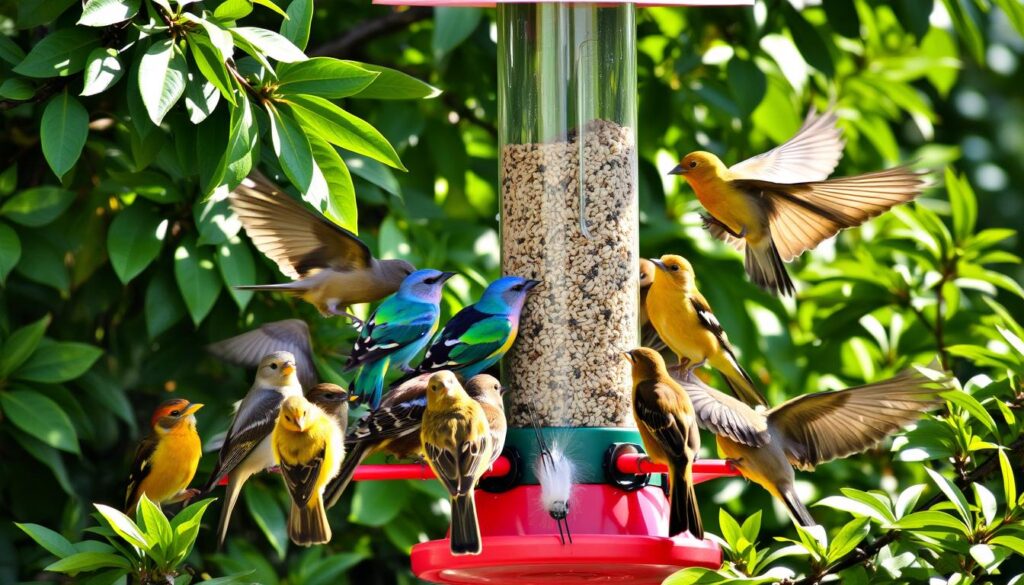Did you know over 100 North American bird species eat from bird feeders? They enjoy birdseed, suet, fruit, and nectar. This is especially true in winter when food is hard to find. It also helps during spring and fall migrations.
To attract birds, offer a variety of quality seed. Make sure there’s always fresh water for drinking and bathing. And, don’t forget to provide cover from native plants.
In this guide, we’ll dive into the world of bird feeding habits. We’ll look at the avian digestive system and the amazing adaptations of bird beaks. Whether you’re new to birdwatching or a seasoned enthusiast, this article will help you create a bird-friendly space.
Key Takeaways:
- Backyard bird feeding helps ensure food availability during migration and winter months.
- Different bird food compositions are required to meet the seasonal nutritional needs of birds.
- Proper feeder placement and maintenance are crucial to prevent disease spread and window collisions.
- Supplemental feeding can benefit individual birds, but experts debate its long-term impact on bird populations.
- Creating a bird-friendly environment with native plants and safe feeding stations is essential for attracting a variety of bird species.
Understanding Bird Feeding Basics
Wild birds mostly eat seeds, berries, insects, and small animals. But, feeding them extra can really help, especially when food is hard to find. Setting up bird feeders in your yard or garden gives them a steady food source. This is especially important during migration and winter.
Natural vs. Supplemental Feeding
Birds can find their own food, but extra help is welcome. Over 100 bird species in North America use birdseed, suet, fruit, and nectar from feeders. This extra food is key in winter when food is scarce.
Benefits of Feeding Wild Birds
Feeding wild birds has many benefits. It lets people see different species up close and learn about them. It also helps birds get through tough times and bad weather. Feeding birds benefits them most during the winter months when natural food supplies are limited.
Best Times for Bird Feeding
The best times to see birds at feeders are early morning and just before dusk. Birds are most active then, looking for food for the day or night. While they might visit feeders any time, they’re less active in the afternoon and on rainy days.
| Feeding Period | Bird Activity |
|---|---|
| Early Morning | High, as birds seek food to start their day |
| Afternoon | Lower, as birds are less active during the heat of the day |
| Just Before Dusk | High, as birds prepare for the night and need to replenish energy |
| Rainy Weather | Lower, as birds may seek shelter and natural food sources |
Learning about bird feeding basics helps create a welcoming space for birds. This supports their health and happiness.
How Do Birds Eat?
Birds have many ways to eat, depending on what they like to eat. Some, like sparrows and juncos, look for food on the ground. Others, like finches and cardinals, find it in shrubs. Woodpeckers, chickadees, and titmice eat in trees, using their beaks to get insects and seeds.
Birds can’t chew like mammals do. But they use their beaks to tear food into smaller bits. Raptors tear off pieces from meat, while others swallow food whole by tilting their heads back.
The crop holds food before it’s digested in the stomach. The gizzard, a strong organ, grinds food with gravel and grit. The length of a bird’s intestines depends on what it eats, with insect-eaters having shorter ones.
| Feeding Technique | Bird Species | Food Sources |
|---|---|---|
| Ground feeding | Sparrows, Juncos | Seeds, Insects |
| Shrub feeding | Finches, Cardinals | Berries, Seeds |
| Tree feeding | Woodpeckers, Chickadees, Titmice | Insects, Seeds |
| Aerial feeding | Swallows, Swifts | Flying Insects |
Birds’ digestive systems are perfect for their diets, helping them stay full of energy. Knowing about bird feeding techniques and avian digestive system helps us feed them right and make their homes better.
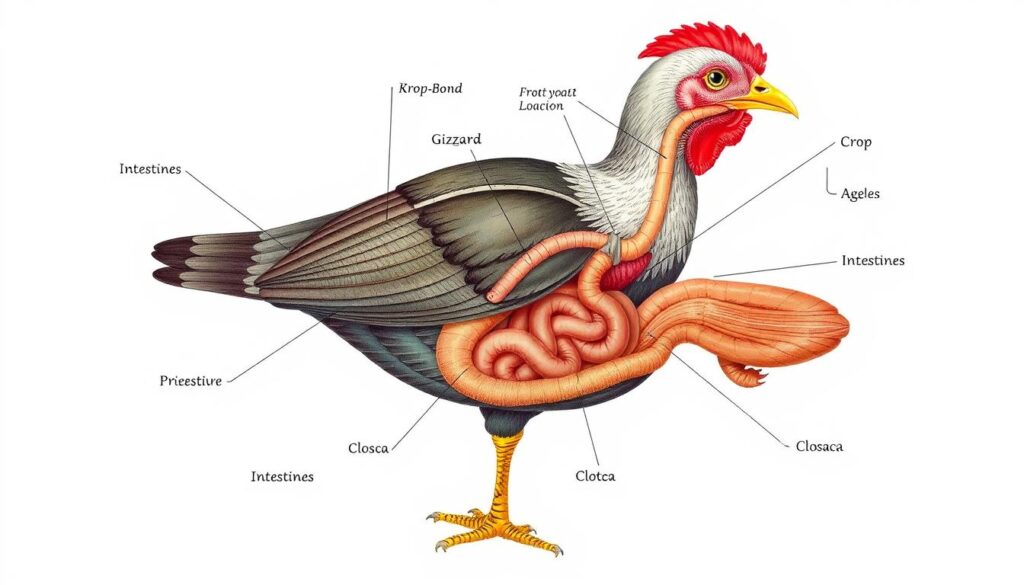
“Offering birds food packed with nutrients is essential for their health, and planting trees and shrubs that provide essential nutrients is beneficial for bird populations.”
Essential Components of a Bird Feeding Station
Creating a welcoming bird feeding station is crucial for attracting many bird species to your backyard. Each part, from different feeders to water sources, is vital. They provide birds with what they need to survive and thrive.
Different Types of Feeders
Choosing the right bird feeder types is key to attracting certain species. Ground platform feeders are great for birds like cardinals and robins. Hopper feeders are perfect for jays and finches. Pole-mounted feeders offer a safe spot to perch and can be protected from pests.
Feeder Placement Guidelines
Where you place your bird feeding station is very important. Feeders should be 10-12 feet away from trees to keep pests out. They should also be 3 feet or more from windows to prevent bird collisions. Installing multiple hooks at different heights adds visual appeal and accommodates various bird sizes.
Water Sources and Bird Baths
Having a reliable source of fresh water is as important as offering different bird foods. A bird bath or a shallow dish filled with water attracts many species. It’s essential to clean it regularly to prevent bacteria and stagnation.
“More than 45 million Americans enjoy watching birds at home or away from home.”
By adding these key elements to your bird feeding station, you can make a safe and welcoming space. This will attract a wide variety of bird species to your backyard.
Types of Bird Food and Their Benefits
Offering different bird food types is essential to draw many birds to your yard. Black-oil sunflower seeds are a favorite among many bird species. Other good options include nyjer seeds, peanuts, millet, and cracked corn.
For birds that eat insects, like woodpeckers and chickadees, suet is a must-have. Fruit and nectar feeders attract colorful birds like orioles and hummingbirds, making your yard lively.
It’s important not to give bread or human food to birds. These foods don’t have the nutrients birds need. Instead, choose high-quality bird feed to keep your feathered friends happy and healthy.
Seed Varieties for Birds
- Sunflower seeds – Attract the widest variety of birds, making them a mainstay for most backyard feeders.
- Safflower seeds – Favored by cardinals, grosbeaks, chickadees, doves, and native sparrows.
- Nyjer or thistle seeds – Popular among small finches such as American Goldfinches, Lesser Goldfinches, Indigo Buntings, Pine Siskins, and Common Redpolls.
- White proso millet – Favored by ground-feeding birds like quails, native American sparrows, doves, towhees, juncos, and cardinals.
- Corn – Eaten by various species including grouse, pheasants, turkeys, quails, cardinals, grosbeaks, crows, ravens, jays, doves, ducks, and cranes.
- Peanuts – Popular with jays, crows, chickadees, titmice, woodpeckers, and other species.
| Bird Food Type | Preferred Bird Species |
|---|---|
| Milo | Favored by many Western ground-feeding birds |
| Rapeseed | Consumed by quails, doves, finches, and juncos |
| Canary seed | Popular with House Sparrows and cowbirds |

“In the UK, an average of £200 – £300 million is spent on bird feeding products annually.”
Seasonal Bird Feeding Guide
Changing how you feed birds in your backyard can really help them. As seasons change, birds’ needs and where they go also change. Knowing these changes lets you feed them right and make your yard a great place for birds.
Spring and Summer Feeding
In spring and summer, birds need lots of protein for breeding and raising young. Give them mealworms, suet, and nyjer seed. Also, keep feeders clean to stop diseases and add moving water to your birdbath to attract more birds.
Fall Migration Needs
In autumn, birds start their long journey south. Feed them high-fat foods like peanuts, sunflower seeds, and suet. Clean feeders well to keep food coming during their big trip. Watch for orioles and hummingbirds as they head to warmer places.
Winter Feeding Strategies
Winter is tough for birds because food is hard to find. Give them suet, nyjer seed, and black-oil sunflower seeds to keep warm. Clean and fill feeders often to keep food coming.
By changing how you feed birds with the seasons, you make your backyard a great place for them all year. A well-fed and clean feeding station brings joy and helps local birds.
Bird Feeding Heights and Locations
The height and placement of bird feeders are key to attracting many bird species. Where you place your feeders can greatly affect the types of birds that visit your backyard.
It’s wise to have feeders at different heights to meet the needs of various birds. For example, cardinals and finches like feeders at 5-6 feet. Woodpeckers prefer heights of 6-10 feet. Hummingbirds are drawn to flowers at 3-6 feet, and sparrows and towhees like the ground at 1-5 feet.
Chickadees and titmice do well at 5-10 feet, while bluebirds like 5-7 feet. Orioles prefer 6-10 feet in bushes and trees. By placing feeders at these heights, you can attract a wide range of birds.
Most experts suggest placing feeders at 5-6 feet for safety and ease of access. This height is perfect for both the birds and for refilling the feeders. Feeders that are too low can attract pests, while those too high may be out of reach for smaller birds.
| Bird Species | Preferred Feeding Height |
|---|---|
| Cardinals and Finches | 5-6 feet |
| Woodpeckers | 6-10 feet |
| Hummingbirds | 3-6 feet |
| Sparrows and Towhees | 1-5 feet |
| Chickadees and Titmice | 5-10 feet |
| Bluebirds | 5-7 feet |
| Orioles | 6-10 feet |
By thinking about bird feeder placement and feeding station layout, you can create a welcoming space for birds. This will make your bird-watching adventures even more enjoyable.
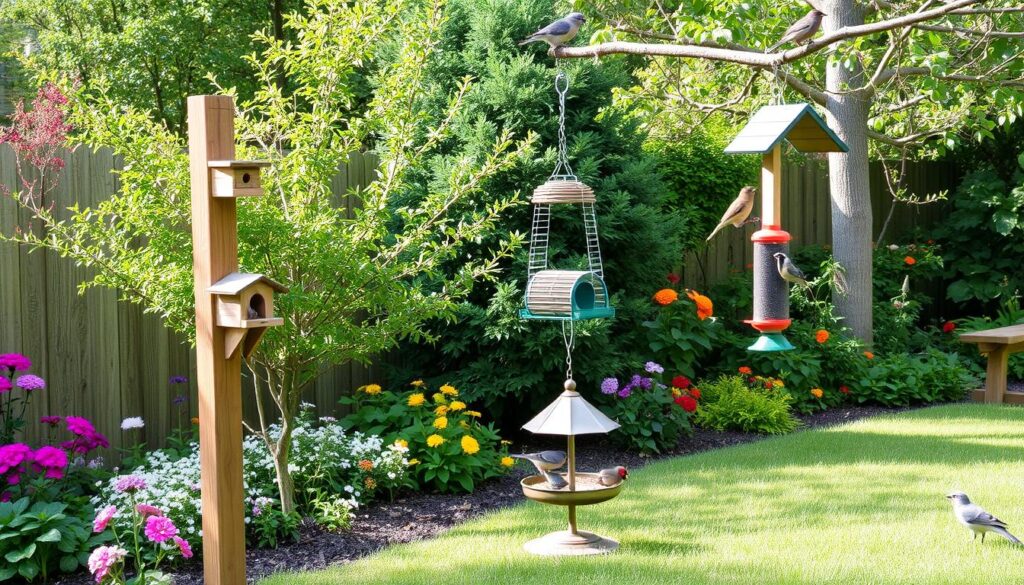
Attracting Different Bird Species
To attract many bird species to your backyard, you need to meet their unique food needs. Ground-dwelling birds like sparrows and doves like open feeders or seeds on the ground. Tree-dwelling birds, such as titmice, prefer hanging feeders where they can perch and eat.
For attracting special birds, use specific feeders. Hummingbirds love nectar feeders, while woodpeckers enjoy suet cages. Offering a variety of seeds, fruits, and insects creates a feast for many birds.
Ground Feeding Birds
- Sparrows
- Juncos
- Doves
- Blackbirds
- Robins
Tree-Dwelling Birds
- Titmice
- Chickadees
- Nuthatches
- Finches
- Woodpeckers
Specialty Feeders for Specific Species
| Bird Species | Specialty Feeder |
|---|---|
| Hummingbirds | Nectar Feeders |
| Woodpeckers | Suet Cages |
| Finches | Tube Feeders |
| Bluebirds | Mealworm Feeders |
By choosing the right feeders and food, you can attract many bird species to your backyard. This will make your yard a lively place that brings joy for years.
Proper Food Storage and Maintenance
Keeping bird seed fresh is key to feeding our feathered friends well. Store seed in metal containers with tight lids to keep it dry and pest-free. Also, place the containers in a cool, dry spot to stop mold from growing.
It’s just as important to keep feeders clean. Clean them at least twice a year with a 10% non-chlorine bleach solution. This removes dirt and harmful stuff. Also, clean up spilled seeds and hulls to keep the area inviting for birds.
| Cleaning Frequency | Cleaning Solution | Cleaning Tip |
|---|---|---|
| Seed Feeders: At least once per month | 1 part liquid chlorine bleach to 9 parts hot water | Thoroughly rinse and air-dry before refilling |
| Nectar Feeders: Every 3-4 days during warmer months | Mild soap and warm water | Avoid using the dishwasher or hot water |
By following these tips for bird seed storage and feeder maintenance, you help your backyard birds. They get a safe, reliable food source. Plus, you prevent diseases. A little care in bird feeding station upkeep supports your local bird community’s health.
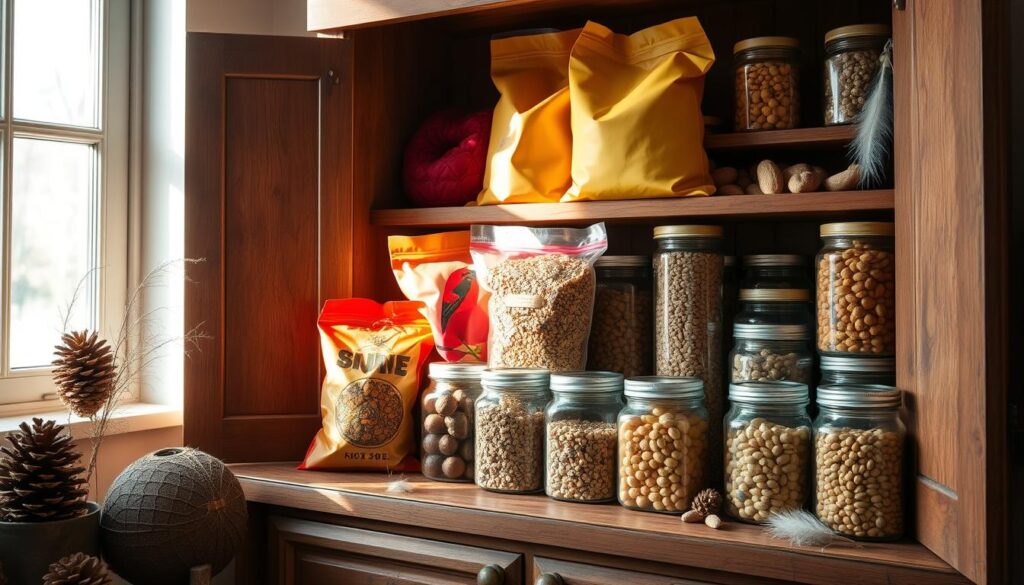
Safety Measures and Predator Protection
Keeping your birds safe is very important when you feed them. To stop predators, use a few safety steps around your bird feeder. First, add baffles to pole feeders to keep out squirrels. Also, place feeders at least 10 feet from trees to block cats, snakes, and hawks.
Keeping your feeder clean is also key. Change birdbath water every day in hot weather to avoid bacteria. Also, replace bird food every 3-4 days on dry days, or daily in wet weather. Clean feeders with a 1-to-9 bleach-to-water mix to keep birds healthy.
- Elevate nesting boxes at least 8 feet off the ground to safeguard eggs and baby birds from ground-based predators.
- Consider using feeders without perches to discourage squirrels, raccoons, and hawks from accessing the food.
- Install decals on windows or ensure they are not reflective to prevent birds from colliding with them.
By taking these bird feeder safety and predator prevention steps, you make your backyard a safe haven for birds. They can then enjoy their meals without fear of harm.
Common Bird Feeding Mistakes to Avoid
Feeding birds can be a fun hobby, but we must avoid mistakes that harm them. Giving the wrong food and not cleaning feeders are big errors. These mistakes can hurt the health of birds in our area.
Inappropriate Foods
One big bird feeding error is giving the wrong food. Bread is bad for birds because it lacks nutrients and can hurt their stomachs. Instead, use high-quality bird seed, suet cakes, and fresh fruit to feed them well.
Poor Feeder Maintenance
Keeping your feeder maintenance up-to-date is key to stop diseases in birds. Clean feeders weekly with a mix of water and bleach. Also, change seed in dry feeders every 5-7 days to stop mold and pests.
Wrong Feeder Placement
The spot where you put bird feeders is very important. Feeders too close to windows can cause birds to crash into them. And feeders too close to your house can attract predators. Try to place them at least 30 feet away from your house for safety.
By avoiding these common bird feeding errors and feeder maintenance mistakes, you can make a safe place for birds. Small changes can help a lot in supporting our feathered friends.
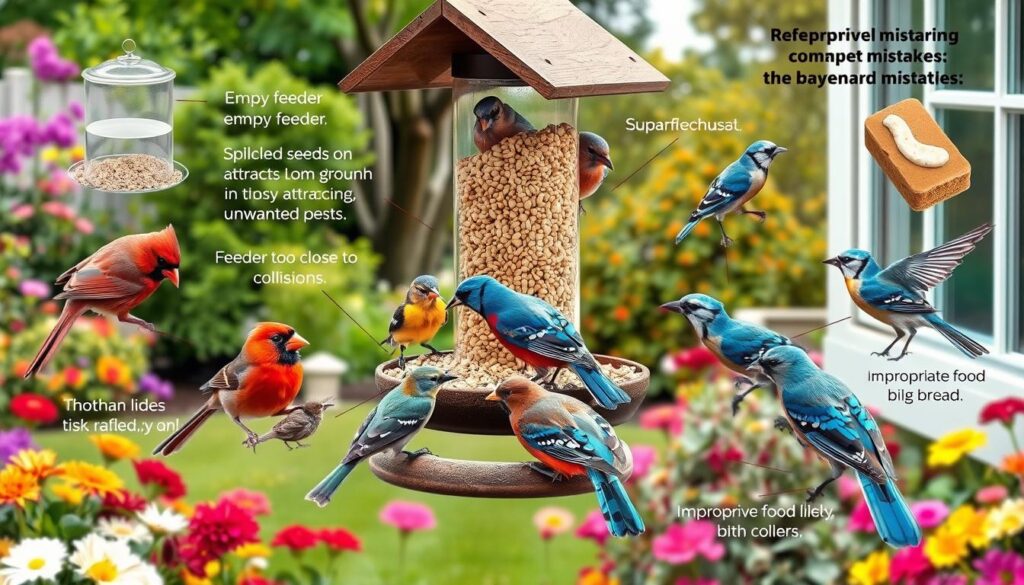
Disease Prevention and Feeder Hygiene
Keeping bird feeders clean is key to stopping diseases in birds. Wildlife biologist Todd Schneider says cleaning feeders often is vital for bird health.
Bacteria like salmonellosis spread through bird droppings and old seed hulls. These can make birds tired or even sick without showing signs. Fungi like aspergillosis can also cause breathing problems from wet, moldy seeds.
To fight these issues, use a 10% non-chlorine bleach solution to clean feeders. Always wear gloves and avoid touching your face to avoid getting sick. Make sure the area around feeders is clean and free of old food.
If you see many sick or dead birds, tell the Wildlife Conservation Section of your local Department of Natural Resources (DNR). This helps them deal with disease outbreaks and protect birds.
The avian flu has raised worries about songbirds, but experts think it’s unlikely to spread widely among them. Still, keeping feeders clean and watching for sickness is important for bird health.
By following these easy steps and staying up-to-date on bird disease, we help our feathered friends. A clean bird feeder is not just nice to look at. It’s also crucial for supporting local birds.
Creating a Bird-Friendly Environment
Turning your yard into a bird haven is rewarding. It supports local wildlife and makes your outdoor space beautiful. By using native plants, you can make a bird paradise in your backyard.
Choose a variety of native trees, shrubs, and ground covers. They meet different bird needs. The National Wildlife Federation says native plants feed 96% of land birds.
Adding a birdbath or small pond is key. It gives birds water for drinking and bathing. Stay away from pesticides and herbicides to keep your habitat balanced.
In spring, offer nesting materials like soft plant fibers or dryer lint. Place bird feeders near plants to meet their needs.
By focusing on bird-friendly landscaping and natural bird habitats, your yard becomes a lively, eco-friendly spot. It attracts many bird species and makes your property more beautiful.
“Planting native plants is one of the single most effective actions a homeowner can take to support local birds and other wildlife.”
– Doug Tallamy, renowned entomologist and author
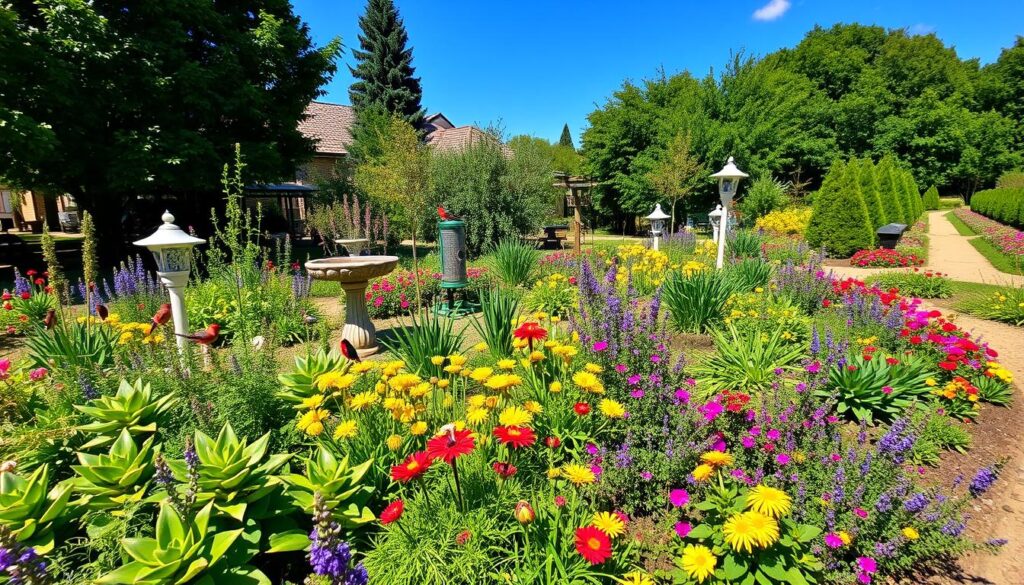
- Use a mix of canopy trees, understory trees, berry shrubs, and native grasses for food and shelter.
- Choose plants that bloom at different times for constant food sources.
- Avoid non-native plants that don’t help local birds much.
- Make sure there’s a reliable water source, like a birdbath or pond.
- Don’t use pesticides and herbicides to keep your habitat balanced.
Design your yard with bird-friendly landscaping and natural bird habitats in mind. This way, you’ll have a lively, eco-friendly space that supports wildlife and looks great.
Managing Unwanted Visitors
Having a variety of birds in your backyard is rewarding. But, you need to keep unwanted visitors away from your bird feeders. Squirrels are known for raiding these feeders and causing trouble. To keep them out, use squirrel deterrents like baffles or special feeders that block their access.
Where you place your bird feeders is key in pest control for bird feeders. Put them far from trees, houses, or other places squirrels can jump to. You might also set up separate feeding spots for squirrels or other wildlife. This way, they won’t bother your bird feeders.
Choose bird seed that’s not so tasty to other animals. This can help keep unwanted visitors away. Also, clean up any spilled seed or waste right away. This stops rodents, raccoons, and other pests from coming. By doing these things, you can make your bird-feeding area safe and fun for birds, while keeping pests away.
FAQ
How do birds eat?
Birds eat in many ways, depending on what they like to eat. Some, like sparrows, eat on the ground. Others, like finches, prefer eating in shrubs. Woodpeckers and chickadees usually eat in trees.
Their digestive system is made to quickly process food. This helps them stay warm and keep their energy up.
What are the benefits of feeding wild birds?
Feeding wild birds helps them a lot in winter when food is hard to find. It also helps in spring and fall when they migrate. To attract birds, you need good seed, fresh water, and plants for cover.
What are the best times for bird watching at feeders?
The best times to watch birds are early morning and just before dusk. Feeding them lets you see different birds up close. You can learn about the birds that visit your area.
What types of bird feeders and placements should be used?
You need different feeders for different birds. Place them in safe spots to avoid predators and window crashes. Make sure there’s water nearby too.
Put feeders at different heights for birds that eat on the ground, in shrubs, or in trees. Keep them far from windows to prevent accidents.
What types of bird food should be offered?
Offer a variety of foods to attract many birds. Black-oil sunflower seeds are a favorite. Nyjer seeds, peanuts, millet, and cracked corn are also good choices.
Suet is great for birds that eat insects. Fruit and nectar feeders attract orioles and hummingbirds. But don’t give them bread or human food, as it’s not good for them.
How should bird feeding strategies be adjusted seasonally?
Change how you feed birds with the seasons. In spring and summer, give them high-protein foods for breeding. In fall, give them high-fat foods for migration.
In winter, give them high-energy foods to stay warm. Change the types and amounts of seeds based on the season and the birds you see.
How can I attract specific bird species to my yard?
To attract certain birds, tailor your feeding strategy. Ground feeders like open platforms or scattered seeds. Tree-dwelling birds prefer hanging feeders.
Use nectar feeders for hummingbirds and suet cages for woodpeckers. Offer a mix of seeds, fruits, and insects to attract many species.
How should bird seed and feeders be stored and maintained?
Store bird seed in metal containers with tight lids to keep it dry and pest-free. Keep it in a cool, dry place to prevent mold. Clean feeders at least twice a year with a 10% non-chlorine bleach solution.
Rake up spilled seeds and hulls to keep the area clean and prevent mold.
What safety measures should be taken when feeding wild birds?
To keep birds safe, use baffles on pole-mounted feeders to keep out squirrels. Place feeders far from where cats can hide. Keep them at least 10 feet from shrubs or trees to avoid predators.
Consider using squirrel-proof feeders or giving squirrels their own feeding station to reduce competition.
What are common mistakes to avoid when feeding birds?
Don’t give them bread or human food, as it’s not nutritious. Keep feeders clean to prevent disease. Place them safely to avoid window crashes and predators.
Don’t use pesticides or herbicides near feeders. Make sure to feed them regularly, especially in bad weather.
How can I prevent the spread of diseases at my bird feeders?
Clean feeders often to stop diseases like E. coli and Salmonella. Use a 10% non-chlorine bleach solution for cleaning. Wear gloves and avoid touching your face when cleaning.
Keep the area around feeders free of droppings and old food. Watch for sick birds and remove feeders if disease is suspected.
